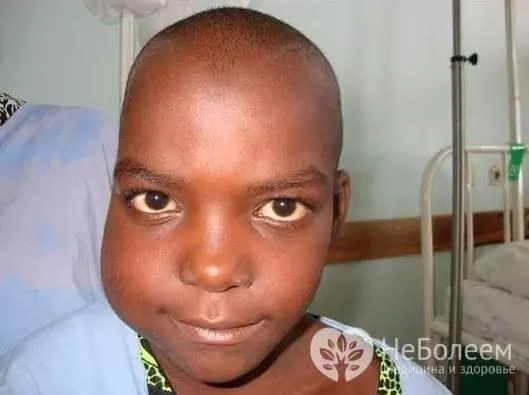- Author Rachel Wainwright [email protected].
- Public 2023-12-15 07:39.
- Last modified 2025-11-02 20:14.
Burkitt's lymphoma
The content of the article:
- Causes and risk factors
- Disease stages
- Burkitt's lymphoma symptoms
- Diagnostics
- Burkitt's lymphoma treatment
- Potential consequences and complications
- Forecast
- Prevention
Burkitt's (Burkett's) lymphoma is a malignant disease characterized by uncontrolled proliferation of immature lymphoid cells. It belongs to the group of non-Hodgkin B-cell lymphomas, it is characterized by an extremely malignant course. The pathological process quickly goes beyond the lymphatic system and affects the bone marrow, central nervous system and internal organs.

Approximately 80% of the total number of cases of Burkitt's lymphoma is an endemic form, common in New Guinea and South Africa and affecting mainly children aged 4 to 7 years. Girls get sick half as often as boys.
Sporadic forms of Burkitt's lymphoma occur in all countries of the world. They account for approximately 1% of all cases of lymphoma. The disease mainly affects people under 30 years of age, men 2.5 times more often than women.
Most patients with Burkitt's lymphoma are infected with Epstein-Barr virus and / or human immunodeficiency virus (HIV), which suggests that these viruses are involved in the pathological mechanism of the disease. In Russia, Burkitt's lymphoma is extremely rare.
Causes and risk factors
The exact cause of Burkitt's lymphoma has not been established. It is known to be frequently associated with infection with the Epstein-Barr virus. However, despite this, most experts believe that Burkitt's lymphoma in children and adults is a polyetiological disease, that is, not one, but a combination of several causes (viral infections, ionizing radiation, contact with potential carcinogens, immunodeficiency states, unfavorable living conditions).
The Epstein-Barr virus is widespread. It infects approximately 95% of adults and 50% of children in North America. After infection, the virus in the human body is dormant for many years. The list of associated diseases is quite extensive. In addition to Burkitt's lymphoma, it includes:
- chronic fatigue syndrome;
- multiple sclerosis;
- herpes;
- Infectious mononucleosis;
- Hodgkin's lymphoma;
- other types of non-Hodgkin lymphomas.
The Epstein-Barr virus has the ability to infect B-lymphocytes and cause them to mutate, as a result of which the lights acquire the ability to constantly proliferate. In all likelihood, it is these B-lymphocytes altered by the virus that form the primary focus of Burkitt's lymphoma.
The higher incidence rate of males is explained, apparently, by the presence of an abnormal X chromosome, which is the reason for the inadequate response of the immune system to infection with the Epstein-Barr virus.
Disease stages
Given the prevalence of the neoplastic process, there are four stages in the course of Burkitt's lymphoma.
- The tumor affects only one anatomical area.
- IIa - the tumor process covers two adjacent areas; IIb is characterized by a tumor affecting more than two anatomical areas located on the side of the diaphragm.
- The tumor spreads to several areas located on opposite sides of the diaphragm.
- Involvement in the malignant process of the central nervous system.
Burkitt's lymphoma symptoms
In most cases, the first symptom of Burkitt's lymphoma is an enlargement of one or more lymph nodes in the submandibular region (lymphadenopathy). The tumor grows rapidly, invading the surrounding tissue. The skin over it is hyperemic. As the disease progresses, patients experience deformity of the face, the thyroid gland is affected, the bones of the facial part of the skull are destroyed, teeth fall out, and difficulty swallowing and breathing occurs. Burkitt's lymphoma in children and adults is always accompanied by intoxication syndrome:
- general weakness;
- increased fatigue;
- decreased appetite;
- excessive sweating;
- headaches, muscle-joint pain;
- increased body temperature.
In clinical practice, the abdominal form of Burkitt's lymphoma is sometimes found. In this case, the primary tumor is localized in the kidneys, intestines, pancreas, and stomach. In this case, Burkitt's lymphoma is manifested by dyspepsia, abdominal pain, fever, and sometimes jaundice.
Burkitt's lymphoma metastases to regional lymph nodes, the central nervous system and bone tissue, which causes neurological disorders (dysfunction of the pelvic organs, paresis, paralysis), pathological fractures and deformities of the limbs.
In rare cases, Burkitt's lymphoma manifests as leukemia, but more often the leukemic phase develops in patients after the primary tumor has reached a significant size.
When the central nervous system is involved in the malignant process, meningeal symptoms and dysfunctions of the cranial nerves appear. In this case, the optic and facial nerves are more affected.
Without therapy, Burkitt's lymphoma progresses rapidly and is fatal weeks or months after the first symptoms appear.
Diagnostics
Diagnosis of Burkitt's lymphoma is carried out on the basis of clinical signs of the disease, anamnesis data and the results of laboratory and instrumental research, including:
- histological examination of a biopsy specimen of the affected lymph node;
- ELISA and PCR for infection with the Epstein-Barr virus, HIV;
- Ultrasound of the abdominal organs;
- X-ray of the skull;
- computed or magnetic resonance imaging;
- sternal puncture with subsequent histological examination of bone marrow punctate.
Burkitt's lymphoma treatment
The main method of treating the disease is polychemotherapy, during which several cytostatic drugs are used simultaneously. Children with Burkitt's lymphoma are prescribed the shortest possible courses of therapy, which reduces the risk of negative consequences (development of other malignant diseases, infertility, growth retardation) in the distant future.
Chemotherapy can be supplemented by the appointment of interferons, immunomodulators, antiviral drugs.
Combined treatment for Burkitt's lymphoma has not been widely adopted. Numerous studies do not confirm an increase in the effectiveness of chemotherapy when combined with radiation therapy in this case.

Source: opuholi.org
Radical removal of the primary tumor in the retroperitoneal space or abdominal cavity does not affect the prognosis of the disease, but improves the quality of life, alleviating symptoms. Surgical removal of Burkit's lymphoma located in the jaw area is contraindicated, since the operation is accompanied by a high risk of intraoperative bleeding due to the abundant growth of the tumor by blood vessels.
In some cases, bone marrow transplantation has a good therapeutic effect.
Potential consequences and complications
The main complications of Burkitt's lymphoma are:
- massive bleeding;
- compression of the ureters with impaired outflow of urine, which leads to the development of kidney block and impaired renal function;
- perforation of hollow organs;
- intestinal obstruction;
- thromboembolism, including pulmonary embolism (PE);
- lower paraplegia associated with a tumor of the spinal cord and spine.
Forecast
The prognosis for Burkitt's lymphoma is always serious. In many respects, it depends on the timeliness of the treatment started. If therapy begins at stage I of the disease, complete recovery is possible. In cases where the tumor metastasizes to the internal organs, bone marrow, and the central nervous system, the prognosis is poor. The lethal outcome occurs against the background of a secondary infection that has joined or developed complications.
Within the first year after completion of therapy, many patients develop a relapse of Burkitt's lymphoma, and the recurrent tumor is often chemotherapy-resistant. In this case, the life expectancy of patients does not exceed 7-10 months.
Prevention
Prevention of Burkitt's lymphoma is currently not developed, since the etiology and pathological mechanism of its development are not fully understood.
YouTube video related to the article:

Elena Minkina Doctor anesthesiologist-resuscitator About the author
Education: graduated from the Tashkent State Medical Institute, specializing in general medicine in 1991. Repeatedly passed refresher courses.
Work experience: anesthesiologist-resuscitator of the city maternity complex, resuscitator of the hemodialysis department.
The information is generalized and provided for informational purposes only. At the first sign of illness, see your doctor. Self-medication is hazardous to health!






